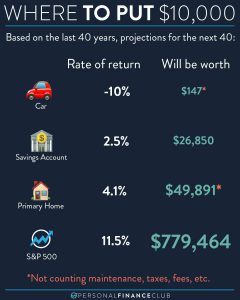
I think one of the most confusing issues facing new investors is what I call the “layers of investing”. There are all these terms thrown around: Stocks, mutual funds, index funds, IRA, 401, brokerages, etc. Which do you need?! Which is best?! Well, once you understand the layers of investing, it should become more clear. Let’s break it down.
Layer 1: Stocks & Bonds. At the core of investing are the actual things that go up in value and provide dividends: stocks and bonds. Back in the day you might have directly held them in the form of a stock certificate, but now it’s easier to buy them in convenient packages. And thus:
Layer 2: Mutual Funds & ETFs. These are packages that contain a BUNCH of stocks and bonds. Instead of having to individually pick a stock, you can buy a mutual fund or ETF and buy a bunch all at once much more simply. Index funds are a type of mutual fund. But these also don’t live in a vacuum. They go inside of:
Layer 3: Investment accounts (e.g. Brokerage Account, Roth IRA, 401k, etc). Just like a checking or savings account, these accounts are associated with your name and taxes and hold the mutual funds and ETFs that you own. But accounts need to be managed somewhere, so they go inside of:
Layer 4: Brokerage (e.g. Vanguard, Fidelity, Robinhood, etc). These companies help you open and manage your investment accounts. They have helpful websites and tools to see how your investments are doing.
So putting it all together, you go to a brokerage (e.g. Vanguard), open an account (e.g. a Roth IRA), purchase an index fund (e.g. VTSAX) and it contains thousands of stocks (including Apple, Amazon, Tesla, etc).
So 401(k) vs index fund doesn’t make sense. Index funds can go INSIDE your 401k. 401ks happen to be SPECIAL accounts that are only available through a workplace retirement plan, but I’m running out of room, so check my other posts on them! 🙂
As always, reminding you to build wealth by following the two PFC rules: 1.) Live below your means and 2.) Invest early and often.
-Jeremy
via Instagram

 September Sale!
September Sale! 



